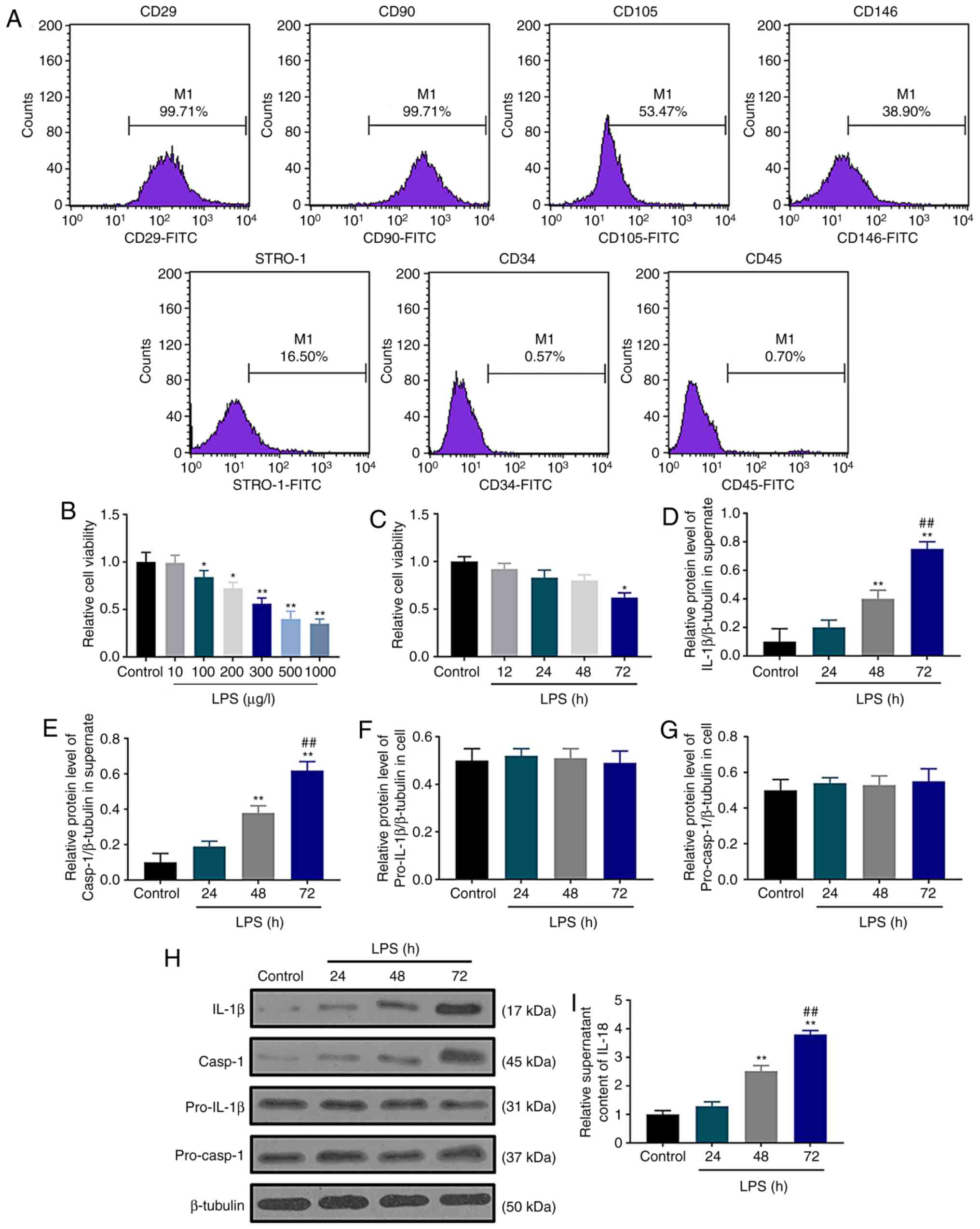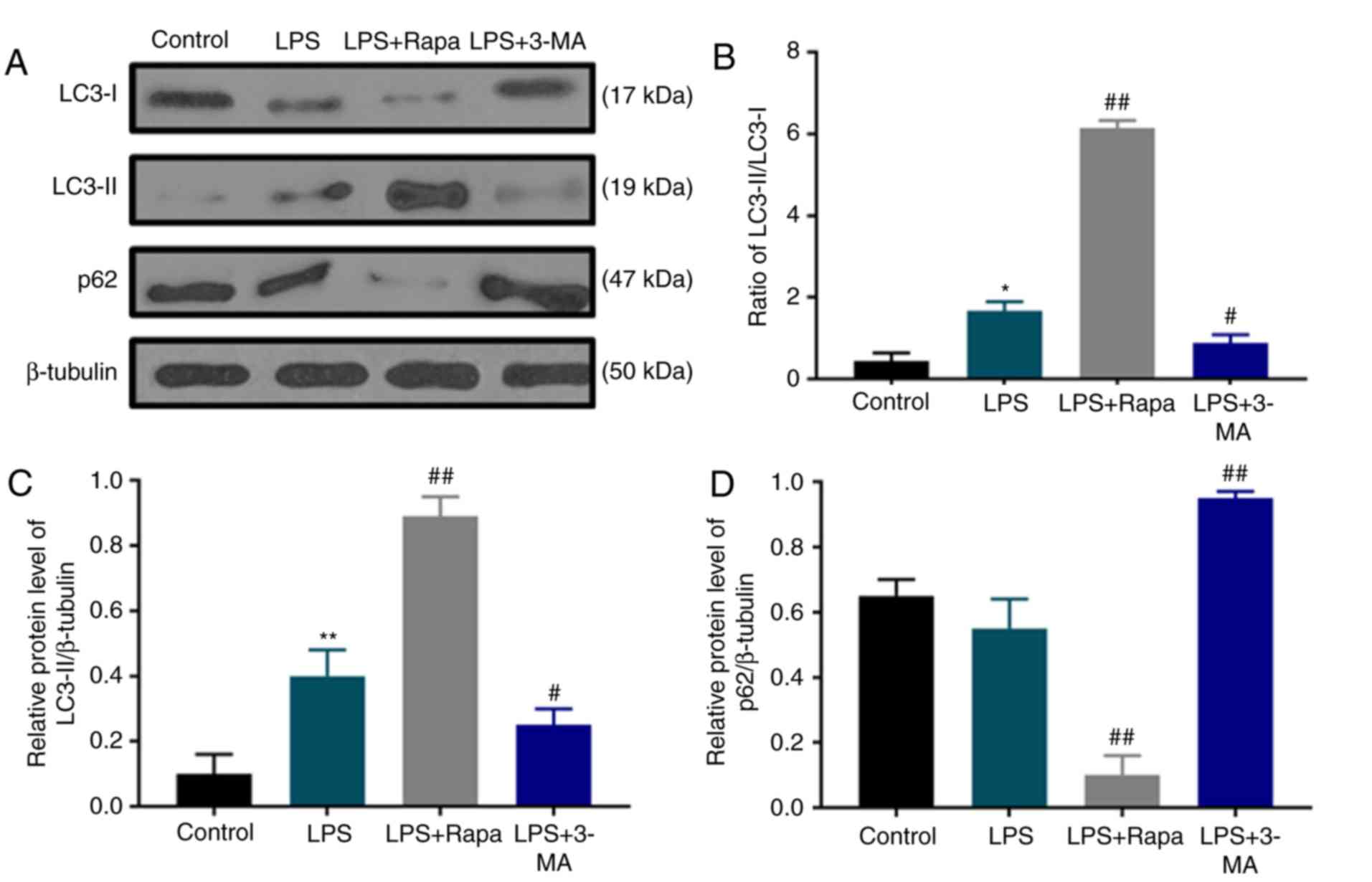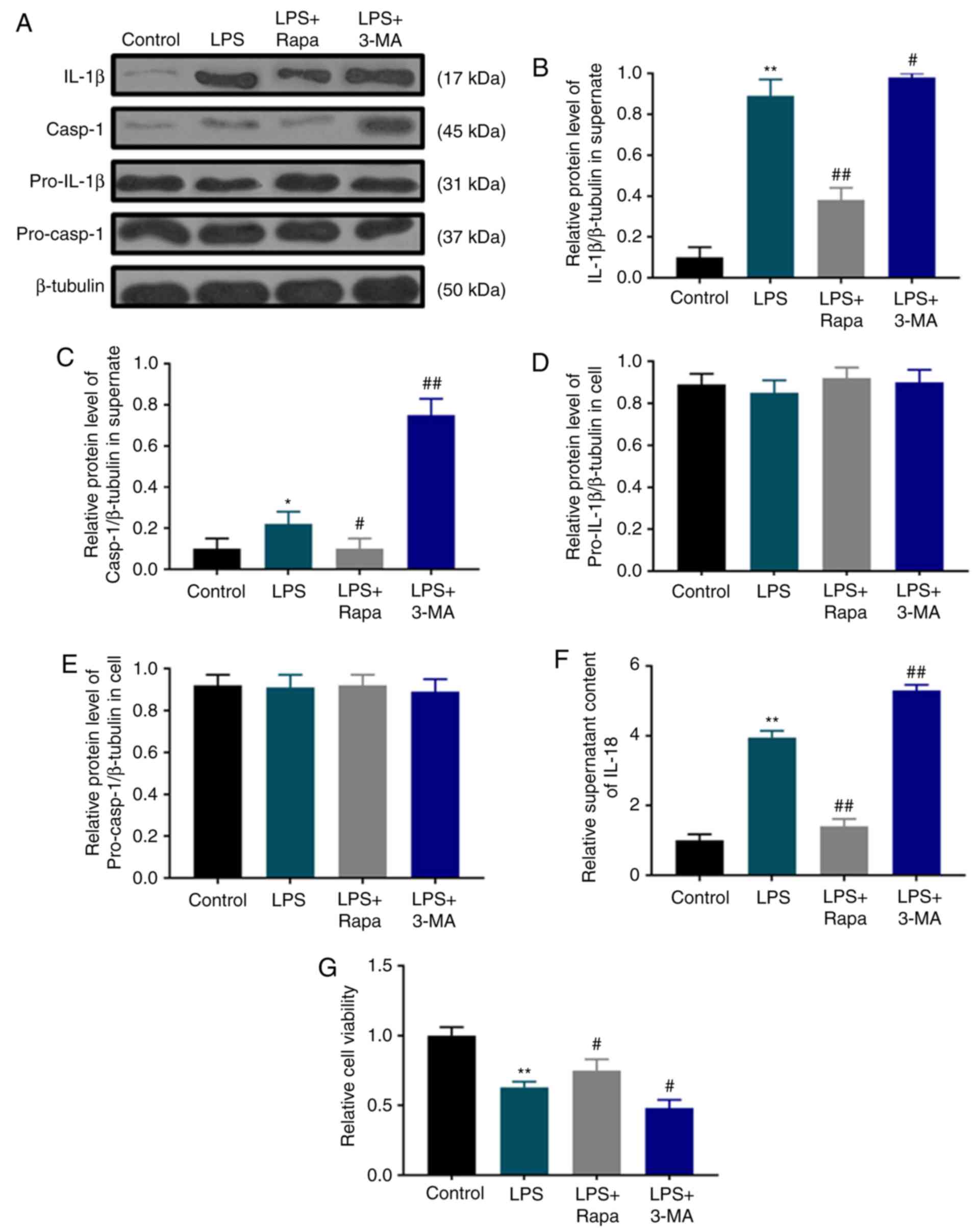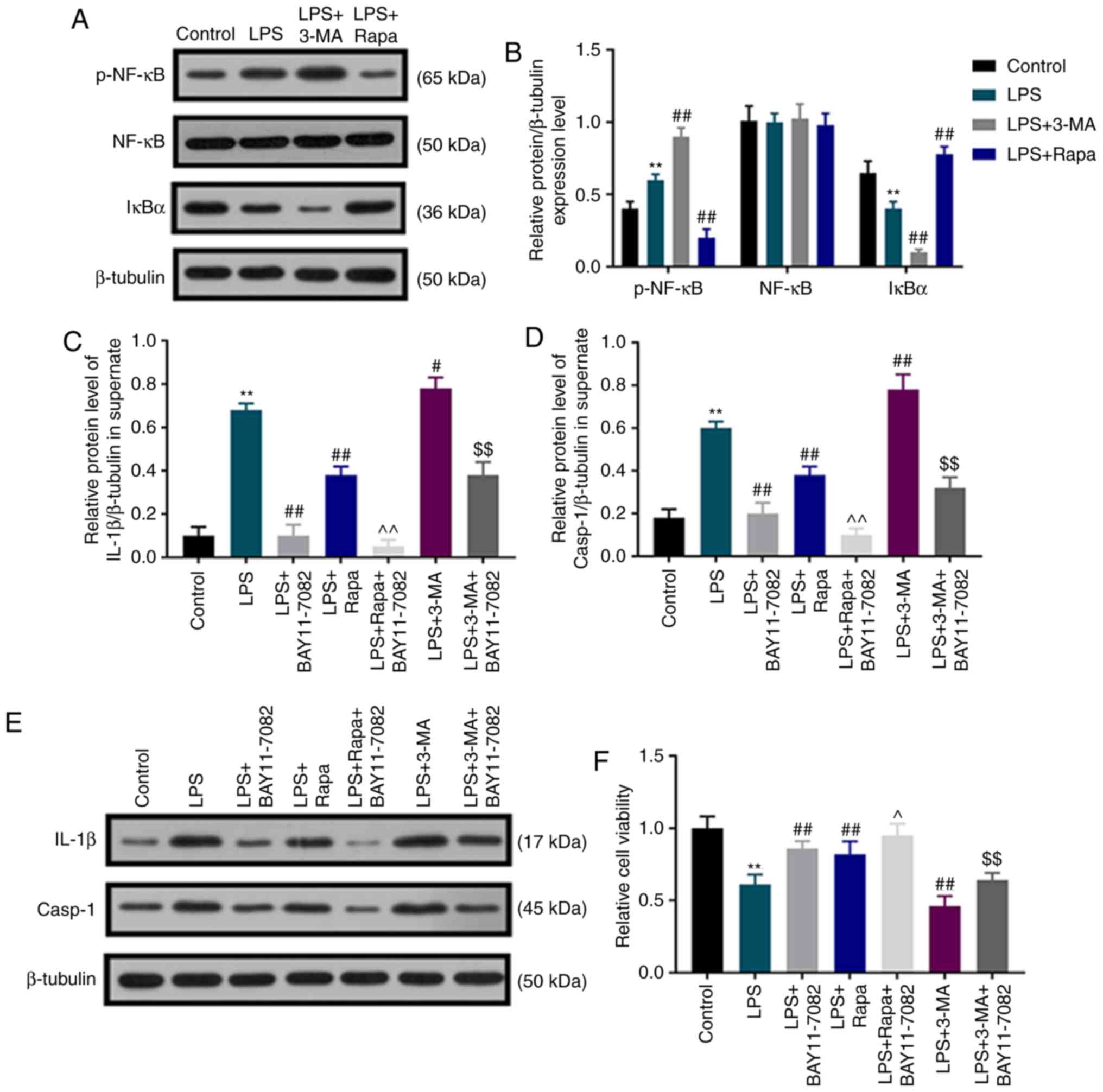|
1
|
Hahn CL and Liewehr FR: Relationships
between caries bacteria, host responses, and clinical signs and
symptoms of pulpitis. J Endod. 33:213–219. 2007. View Article : Google Scholar : PubMed/NCBI
|
|
2
|
Jontell M, Okiji T, Dahlgren U and
Bergenholtz G: Immune defense mechanisms of the dental pulp. Crit
Rev Oral Biol Med. 9:179–200. 1998. View Article : Google Scholar : PubMed/NCBI
|
|
3
|
Zhang A, Wang P, Ma X, Yin X, Li J, Wang
H, Jiang W, Jia Q and Ni L: Mechanisms that lead to the regulation
of NLRP3 inflammasome expression and activation in human dental
pulp fibroblasts. Mol Immunol. 66:253–262. 2015. View Article : Google Scholar : PubMed/NCBI
|
|
4
|
Sood AK, Burbank AJ, Duran CG, Enders K,
Zhou H, Peden DB and Hernandez ML: Gamma tocopherol effect on
LPS-induced sputum neutrophilia is not modified by BMI or GSTM1
genotype. J Allergy Clin Immunol. 143:1937–1939. 2019. View Article : Google Scholar : PubMed/NCBI
|
|
5
|
Tang Y, Wang C, Wang Y, Zhang J, Wang F,
Li L, Meng X, Li G, Li Y and Wang L: Isoliquiritigenin attenuates
LPS-induced AKI by suppression of inflammation involving NF-κB
pathway. Am J Transl Res. 10:4141–4151. 2018.PubMed/NCBI
|
|
6
|
Li S, Ning LG, Lou XH and Xu GQ:
Necroptosis in inflammatory bowel disease and other intestinal
diseases. World J Clin Cases. 6:745–752. 2018. View Article : Google Scholar : PubMed/NCBI
|
|
7
|
Chimenti MS, Sunzini F, Fiorucci L, Botti
E, Fonti GL, Conigliaro P, Triggianese P, Costa L, Caso F, Giunta
A, et al: Potential role of cytochrome c and tryptase in psoriasis
and psoriatic arthritis pathogenesis: Focus on resistance to
apoptosis and oxidative stress. Front Immunol. 9:23632018.
View Article : Google Scholar : PubMed/NCBI
|
|
8
|
Brough D and Rothwell NJ:
Caspase-1-dependent processing of pro-interleukin-1beta is
cytosolic and precedes cell death. J Cell Sci. 120:772–781. 2007.
View Article : Google Scholar : PubMed/NCBI
|
|
9
|
He Y, Hara H and Núñez G: Mechanism and
regulation of NLRP3 inflammasome activation. Trends Biochem Sci.
41:1012–1021. 2016. View Article : Google Scholar : PubMed/NCBI
|
|
10
|
Jiang W, Lv H, Wang H, Wang D, Sun S, Jia
Q, Wang P, Song B and Ni L: Activation of the NLRP3/caspase-1
inflammasome in human dental pulp tissue and human dental pulp
fibroblasts. Cell Tissue Res. 361:541–555. 2015. View Article : Google Scholar : PubMed/NCBI
|
|
11
|
Zhang H and Sun SC: NF-κB in inflammation
and renal diseases. Cell Biosci. 5:632015. View Article : Google Scholar : PubMed/NCBI
|
|
12
|
Bhatt D and Ghosh S: Regulation of the
NF-κB-mediated transcription of inflammatory genes. Front Immunol.
5:712014. View Article : Google Scholar : PubMed/NCBI
|
|
13
|
Denton D, Xu T and Kumar S: Autophagy as a
pro-death pathway. Immunol Cell Biol. 93:35–42. 2015. View Article : Google Scholar : PubMed/NCBI
|
|
14
|
Guan JL, Simon AK, Prescott M, Menendez
JA, Liu F, Wang F, Wang C, Wolvetang E, Vazquez-Martin A and Zhang
J: Autophagy in stem cells. Autophagy. 9:830–849. 2013. View Article : Google Scholar : PubMed/NCBI
|
|
15
|
Nikoletopoulou V, Papandreou ME and
Tavernarakis N: Autophagy in the physiology and pathology of the
central nervous system. Cell Death Differ. 22:398–407. 2015.
View Article : Google Scholar : PubMed/NCBI
|
|
16
|
Levine B, Mizushima N and Virgin HW:
Autophagy in immunity and inflammation. Nature. 469:323–335. 2011.
View Article : Google Scholar : PubMed/NCBI
|
|
17
|
Levine B and Klionsky DJ: Development by
self-digestion: Molecular mechanisms and biological functions of
autophagy. Dev Cell. 6:463–477. 2004. View Article : Google Scholar : PubMed/NCBI
|
|
18
|
Deretic V, Jiang S and Dupont N: Autophagy
intersections with conventional and unconventional secretion in
tissue development, remodeling and inflammation. Trends Cell Biol.
22:397–406. 2012. View Article : Google Scholar : PubMed/NCBI
|
|
19
|
Couve E, Osorio R and Schmachtenberg O:
The amazing odontoblast: Activity, autophagy, and aging. J Dent
Res. 92:765–772. 2013. View Article : Google Scholar : PubMed/NCBI
|
|
20
|
Yang J, Wan C, Nie S, Jian S, Sun Z, Zhang
L and Chen Z: Localization of Beclin1 in mouse developing tooth
germs: Possible implication of the interrelation between autophagy
and apoptosis. J Mol Histol. 44:619–627. 2013. View Article : Google Scholar : PubMed/NCBI
|
|
21
|
Mankowski RT, Ahmed S, Beaver T, Dirain M,
Han C, Hess P, Martin T, Smith BK, Someya S, Leeuwenburgh C and
Martin AD: Intraoperative hemidiaphragm electrical stimulation
reduces oxidative stress and upregulates autophagy in surgery
patients undergoing mechanical ventilation: Exploratory study. J
Transl Med. 14:3052016. View Article : Google Scholar : PubMed/NCBI
|
|
22
|
Caramés B, Taniguchi N, Otsuki S, Blanco
FJ and Lotz M: Autophagy is a protective mechanism in normal
cartilage, and its aging-related loss is linked with cell death and
osteoarthritis. Arthritis Rheum. 62:791–801. 2010. View Article : Google Scholar : PubMed/NCBI
|
|
23
|
Pei F, Lin H, Liu H, Li L, Zhang L and
Chen Z: Dual role of autophagy in lipopolysaccharide-induced
preodontoblastic cells. J Dent Res. 94:175–182. 2015. View Article : Google Scholar : PubMed/NCBI
|
|
24
|
Meng N, Wu L, Gao J, Zhao J, Su L, Su H,
Zhang S and Miao J: Lipopolysaccharide induces autophagy through
BIRC2 in human umbilical vein endothelial cells. J Cell Physiol.
225:174–179. 2010. View Article : Google Scholar : PubMed/NCBI
|
|
25
|
Hickson-Bick DL, Jones C and Buja LM:
Stimulation of mitochondrial biogenesis and autophagy by
lipopolysaccharide in the neonatal rat cardiomyocyte protects
against programmed cell death. J Mol Cell Cardiol. 44:411–418.
2008. View Article : Google Scholar : PubMed/NCBI
|
|
26
|
Xu Y, Kim SO, Li Y and Han J: Autophagy
contributes to caspase-independent macrophage cell death. J Biol
Chem. 281:19179–19187. 2006. View Article : Google Scholar : PubMed/NCBI
|
|
27
|
Jung JY, Woo SM, Kim WJ, Lee BN, Nör JE,
Min KS, Choi CH, Koh JT, Lee KJ and Hwang YC: Simvastatin inhibits
the expression of inflammatory cytokines and cell adhesion
molecules induced by LPS in human dental pulp cells. Int Endod J.
50:377–386. 2017. View Article : Google Scholar : PubMed/NCBI
|
|
28
|
Li H, Gao A, Feng D, Wang Y, Zhang L, Cui
Y, Li B, Wang Z and Chen G: Evaluation of the protective potential
of brain microvascular endothelial cell autophagy on blood-brain
barrier integrity during experimental cerebral ischemia-reperfusion
injury. Transl Stroke Res. 5:618–626. 2014. View Article : Google Scholar : PubMed/NCBI
|
|
29
|
Kim MJ, Kim EH, Pun NT, Chang JH, Kim JA,
Jeong JH, Choi DY, Kim SH and Park PH: Globular adiponectin
inhibits lipopolysaccharide-primed inflammasomes activation in
macrophages via autophagy induction: The critical role of AMPK
signaling. Int J Mol Sci. 18:E12752017. View Article : Google Scholar : PubMed/NCBI
|
|
30
|
Zhan FL, Liu XY and Wang XB: The role of
MicroRNA-143-5p in the differentiation of dental pulp stem cells
into odontoblasts by targeting Runx2 via the OPG/RANKL signaling
pathway. J Cell Biochem. 119:536–546. 2018. View Article : Google Scholar : PubMed/NCBI
|
|
31
|
Dupont N, Jiang S, Pilli M, Ornatowski W,
Bhattacharya D and Deretic V: Autophagy-based unconventional
secretory pathway for extracellular delivery of IL-1β. EMBO J.
30:4701–4711. 2011. View Article : Google Scholar : PubMed/NCBI
|
|
32
|
Murai H, Okazaki S, Hayashi H, Kawakita A,
Hosoki K, Yasutomi M, Sur S and Ohshima Y: Alternaria extract
activates autophagy that induces IL-18 release from airway
epithelial cells. Biochem Biophys Res Commun. 464:969–974. 2015.
View Article : Google Scholar : PubMed/NCBI
|
|
33
|
Lin YC, Huang DY, Wang JS, Lin YL, Hsieh
SL, Huang KC and Lin WW: Syk is involved in NLRP3
inflammasome-mediated caspase-1 activation through adaptor ASC
phosphorylation and enhanced oligomerization. J Leukoc Biol.
97:825–835. 2015. View Article : Google Scholar : PubMed/NCBI
|
|
34
|
Wu J, Fernandes-Alnemri T and Alnemri ES:
Involvement of the AIM2, NLRC4, and NLRP3 inflammasomes in
caspase-1 activation by Listeria monocytogenes. J Clin Immunol.
30:693–702. 2010. View Article : Google Scholar : PubMed/NCBI
|
|
35
|
Miao EA, Rajan JV and Aderem A:
Caspase-1-induced pyroptotic cell death. Immunol Rev. 243:206–214.
2011. View Article : Google Scholar : PubMed/NCBI
|
|
36
|
Couve E and Schmachtenberg O: Autophagic
activity and aging in human odontoblasts. J Dent Res. 90:523–528.
2011. View Article : Google Scholar : PubMed/NCBI
|
|
37
|
Couve E, Osorio R and Schmachtenberg O:
Mitochondrial autophagy and lipofuscin accumulation in aging
odontoblasts. J Dent Res. 91:696–701. 2012. View Article : Google Scholar : PubMed/NCBI
|
|
38
|
Li L, Zhu YQ, Jiang L and Peng W:
Increased autophagic activity in senescent human dental pulp cells.
Int Endod J. 45:1074–1079. 2012. View Article : Google Scholar : PubMed/NCBI
|
|
39
|
Lee YH, Lee HY, Kim TG, Lee NH, Yu MK and
Yi HK: PPARγ maintains homeostasis through autophagy regulation in
dental pulp. J Dent Res. 94:729–737. 2015. View Article : Google Scholar : PubMed/NCBI
|
|
40
|
Park SY, Sun EG, Lee Y, Kim MS, Kim JH,
Kim WJ and Jung JY: Autophagy induction plays a protective role
against hypoxic stress in human dental pulp cells. J Cell Biochem.
119:1992–2002. 2018. View Article : Google Scholar : PubMed/NCBI
|
|
41
|
Pantovic A, Krstic A, Janjetovic K, Kocic
J, Harhaji-Trajkovic L, Bugarski D and Trajkovic V: Coordinated
time-dependent modulation of AMPK/Akt/mTOR signaling and autophagy
controls osteogenic differentiation of human mesenchymal stem
cells. Bone. 52:524–531. 2013. View Article : Google Scholar : PubMed/NCBI
|
|
42
|
Chang X, He H, Zhu L, Gao J, Wei T, Ma Z
and Yan T: Protective effect of apigenin on Freund's complete
adjuvant-induced arthritis in rats via inhibiting P2X7/NF-κB
pathway. Chem Biol Interact. 236:41–46. 2015. View Article : Google Scholar : PubMed/NCBI
|
|
43
|
Criollo A, Chereau F, Malik SA,
Niso-Santano M, Mariño G, Galluzzi L, Maiuri MC, Baud V and Kroemer
G: Autophagy is required for the activation of NFkappaB. Cell
Cycle. 11:194–199. 2012. View Article : Google Scholar : PubMed/NCBI
|
|
44
|
Schlottmann S, Buback F, Stahl B,
Meierhenrich R, Walter P, Georgieff M and Senftleben U: Prolonged
classical NF-kappaB activation prevents autophagy upon E. coli
stimulation in vitro: A potential resolving mechanism of
inflammation. Mediators Inflamm. 2008:7258542008. View Article : Google Scholar : PubMed/NCBI
|
|
45
|
Jia X, Cao B, An Y, Zhang X and Wang C:
Rapamycin ameliorates lipopolysaccharide-induced acute lung injury
by inhibiting IL-1β and IL-18 production. Int Immunopharmacol.
67:211–219. 2019. View Article : Google Scholar : PubMed/NCBI
|
|
46
|
Meijer AJ and Codogno P: Regulation and
role of autophagy in mammalian cells. Int J Biochem Cell Biol.
36:2445–2462. 2004. View Article : Google Scholar : PubMed/NCBI
|
|
47
|
Liu YC, Gao XX, Chen L and You XQ:
Rapamycin suppresses Aβ25-35- or LPS-induced neuronal
inflammation via modulation of NF-κB signaling. Neuroscience.
355:188–199. 2017. View Article : Google Scholar : PubMed/NCBI
|
|
48
|
Huang HY, Chang HF, Tsai MJ, Chen JS and
Wang MJ: 6-Mercaptopurine attenuates tumor necrosis factor-α
production in microglia through Nur77-mediated transrepression and
PI3K/Akt/mTOR signaling-mediated translational regulation. J
Neuroinflammation. 13:782016. View Article : Google Scholar : PubMed/NCBI
|
|
49
|
Vangan N, Cao Y, Jia X, Bao W, Wang Y, He
Q, Binderiya U, Feng X, Li T, Hao H and Wang Z: mTORC1 mediates
peptidoglycan induced inflammatory cytokines expression and NF-κB
activation in macrophages. Microb Pathog. 99:111–118. 2016.
View Article : Google Scholar : PubMed/NCBI
|
|
50
|
Fielhaber JA, Carroll SF, Dydensborg AB,
Shourian M, Triantafillopoulos A, Harel S, Hussain SN, Bouchard M,
Qureshi ST and Kristof AS: Inhibition of mammalian target of
rapamycin augments lipopolysaccharide-induced lung injury and
apoptosis. J Immunol. 188:4535–4542. 2012. View Article : Google Scholar : PubMed/NCBI
|
|
51
|
Yue Y, Wang Y, Li D, Song Z, Jiao H and
Lin H: A central role for the mammalian target of rapamycin in
LPS-induced anorexia in mice. J Endocrinol. 224:37–47. 2015.
View Article : Google Scholar : PubMed/NCBI
|
|
52
|
Mengke NS, Hu B, Han QP, Deng YY, Fang M,
Xie D, Li A and Zeng HK: Rapamycin inhibits
lipopolysaccharide-induced neuroinflammation in vitro and
in vivo. Mol Med Rep. 14:4957–4966. 2016. View Article : Google Scholar : PubMed/NCBI
|
|
53
|
Okamoto T, Ozawa Y, Kamoshita M, Osada H,
Toda E, Kurihara T, Nagai N, Umezawa K and Tsubota K: The
neuroprotective effect of rapamycin as a modulator of the
mTOR-NF-κB axis during retinal inflammation. PLoS One.
11:e01465172016. View Article : Google Scholar : PubMed/NCBI
|


















